Tēnā koutou and nau mai, haere mai to High Country Matters.
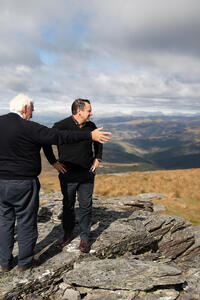
I hope you’re all keeping well and getting used to adjusting to our new normal, as we all do our bit to help stop the spread of COVID-19 and the Delta variant.
The lockdown temporarily halted our pastoral lease visits, but our team was working hard behind the scenes, including preparing to implement the Crown Pastoral Land Reform Bill.
The team is happy to be back out and about reconnecting with our leaseholders on the land. We have a short update in this issue on how our pastoral lease visits will function under the Alert Level guidelines.
I know many of you are interested in the latest on the Crown Pastoral Land Reform Bill.
The Bill is currently progressing through the second reading stage and is halfway through this process, which is due to continue in Parliament shortly. The next step is the Committee of the whole House in Parliament. This stage involves a detailed consideration of each clause (or part) of the Bill.
At this stage, the Government still intends that the Bill is passed before the end of the year. We will keep you posted on this, and you can also track its progress on the Parliament website:
As we’ve mentioned previously, we will work closely with our leaseholders to implement the Bill to assist with a smooth a transition.
Under the current legislation, we are continuing with tenure review and recently reached an agreement for Hukarere, which you can find out about in this issue.
We also introduce you to the pastoral team’s new manager James Holborow.
I hope you enjoy this issue and welcome any feedback on what you would like to see in future editions.
Heoi anō tāku mō nāianei,
Jerome Sheppard – Head of Crown Property
Environmental Defence Society Conference
The South Island high country was a hot topic at the Environmental Defence Society (EDS) Conference in August.
One session was devoted to discussing ‘the future of the high country’.
Hundreds of people from across the environmental and agricultural sector attended the two-day conference, headed ‘Transforming Aotearoa: The Government’s Environmental Reform Agenda’.
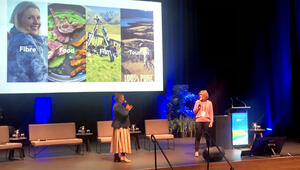
Kate Scott, left, and Kate Cocks speaking at the EDS Conference in August about farming and life in the high country.
Among those who presented were Rees Valley Station leaseholder Kate Scott and Mt Nicholas Station leaseholder Kate Cocks.
The pair gave a great presentation about ‘farming in the high country’, which was well received. It’s now online and you can view it on Vimeo:
The Commissioner of Crown Lands, Craig Harris, joined a panel discussion about ‘what reforms are needed in the high country’. Unfortunately, this is not currently available online.
Our Te Tumu Whakarae / Chief Executive, Gaye Searancke, also attended the conference and gave a presentation (inspired by EDS’s 50th anniversary) about the tools and meticulous methods we have used over the last 50 years to map and measure Aotearoa New Zealand. You can check that out on Vimeo:
A visual tour of our lands and waters
To find out more about the other sessions during the conference, visit the EDS website:
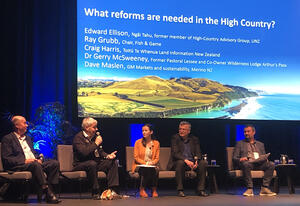
From left to right: Edward Ellison, Dr Gerry McSweeney, Lan Pham, Craig Harris, Dave Maslen, and Ray Grubb discuss the future of the high country.
Pastoral lease visits gear up
After the COVID-19 lockdown, the pastoral team has enjoyed getting out and about and visiting pastoral leases and reconnecting with leaseholders.
Visits are slightly different under Alert Level 2. The team will be following the Government guidelines, including maintaining two-metre distancing and contact tracing.
Portfolio managers will be contacting leaseholders due for a visit this season over the coming weeks to schedule a suitable time around farming commitments.
The team will continue to focus on visiting those pastoral leases that are overdue a visit, but leaseholders who would like a visit are asked to contact their portfolio manager, or alternatively email pastoral&tenurereview@linz.govt.nz.
Tenure review update
There are now 23 properties in tenure review, five of which have accepted substantive proposals under implementation.
This change was due to three leaseholders deciding to withdraw from the process and the recent tenure review agreement for Hukarere Station, in Otago.
Under the agreement for Hukarere Station, 1648 hectares will become conservation land and a new 1038 scenic reserve will be created. The remaining 5529 hectares of the lease will be freeholded, with 394 hectares subject to conservation covenants.
Find out more about this review
We are continuing to work on tenure review until the Crown Pastoral Land Reform Bill comes into effect. At that point, tenure review will end the day after the Bill is passed, except for pastoral leases at the substantive proposal put stage.

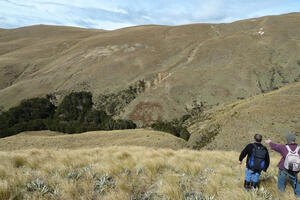
One of the areas on Hukarere Station to become conservation land and surveying the land as part of the tenure review.
New approach to Russell lupins
We have updated our position on Russell lupins on Crown pastoral leases.
These plants, while beautiful and a tourist attraction, are considered a pest in New Zealand and must be controlled as they can easily spread.
While we have previously granted a small number of consents in the past to plant Russell lupins, with a range of conditions to prevent their spread, we will no longer be considering any new requests to do so.
If you have a consent and you’re unsure if it allows planting Russell lupins, please contact your portfolio manager to check.
We appreciate Russell lupins offer some agricultural benefits, such as fodder during drought and to fix nitrogen, but these are outweighed by the risk of them spreading.
We recently confirmed this new position when approached by Stuff:
Struggle against wild lupins sows the seeds of change in the South Island
Meet our new pastoral team manager – James Holborow
James recently took up the position of manager for the pastoral team, joining Toitū Te Whenua in July.
James takes over from April Hussey, who is now leading our Crown Pastoral Land Reform Bill implementation programme.

Prior to Toitū Te Whenua, James worked for the Department of Conservation (DOC) for 15 years. During that time, he did everything from compliance and monitoring through to working with threatened species. His most recent role was leading DOC’s Himalayan tahr programme, a position he held for the last two years.
Highlights from his time at DOC include a dive survey of all 14 fiords, which he says was one of the hardest but most rewarding experiences of his life, and supporting a global information initiative which included sharing sightings of pest species to inform patterns on dispersal, and how best to contain them.
James, who grew up in Dunedin, says his interest in the environment, farming, and the high country started during a school visit to Mt Aspiring.
Ever since then he has tried to spend as much time in the high country and in the great outdoors as possible.
While at university, studying zoology and ecology, he spent his summer holidays working for Manaaki Whenua – Landcare Research surveying as part of the rabbit and land management programme, just as a chance getaway into the high country. He completed a postgraduate degree in marine science at Otago University.
Nowadays, he still tries to get out onto the land whenever he can, although it’s often a lot closer to home and with his wife and young kids, visiting a friend’s dry stock farm in Banks Peninsula, Canterbury.
James says he is looking forward to connecting with leaseholders.
If you have any questions for James, you can contact him on J.Holborow@linz.govt.nz
Partnership to better manage Selwyn Crown pastoral leases
We recently signed a memorandum of understanding (MOU) with Selwyn District Council to share consent information for pastoral leases in the district.
Our Chief Executive Gaye Searancke and Council Chief Executive David Ward signed the MOU on 30 September.
Gaye says both agencies saw an opportunity to work more closely together on consents to achieve better outcomes for the land, as well as make the process easier for leaseholders.
“We were already sharing consent information case-by-case, but this agreement will take that to the next level.
“We will now share information on consents relating to land-use change and development, such as cultivation, earthworks, tracking and removal of native vegetation.
“This will help us make more informed decisions when considering requests to change or develop these special landscapes.
“It will also make things simpler for leaseholders. We will look to make joint visits and to spot early on if leaseholders need to meet any other requirements to comply with their lease conditions, or local and national regulations.”
Gaye says the MOU is the first of its kind for Crown pastoral leases in New Zealand.
To find out more, check out this article on Stuff:
'First-of-its-kind' partnership to better manage Selwyn's Crown pastoral leases
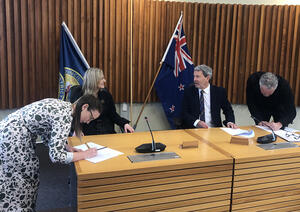
From left to right, April Hussey and Gaye Searancke of Toitū Te Whenua, and David Ward and Andy Spanton of the Selwyn District Council, during the signing of the MOU.
Funding boost to restore braided river valleys, alpine & pastoral land
Toitū Te Whenua is investing $18.4 million over four years to restore braided river valleys, alpine and pastoral lands in South Canterbury.
The funding is from the Government’s Jobs for Nature programme and will see around 40 jobs created each year over the four years.
Toitū Te Whenua will use the funds to deliver three projects to improve the habitat of some of our most fragile plants and animals in Te Manahuna Aoraki, Huxley, Hopkins, and Temple valleys, and braided rivers including the Waitaki, Ashburton South and Stour rivers.
Land Information Minister Damien O’Connor made the funding announcement on 24 September before visiting Mt John Observatory to take in the expansive area where work is happening. Minister O’Connor spoke with attendees including the Glentanner, Mt Hay and Balmoral pastoral leaseholders about their involvement in the Te Manahuna Aoraki project.
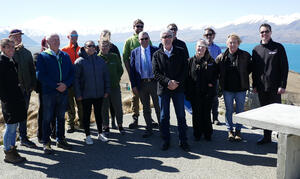
Mt John with Lake Tekapo in the background, 27 September 2021. Photo credit: Toitū Te Whenua.
Minister O’Connor at the Mt John Observatory with representatives from Te Manahuna Aoraki, Te Rūnanga o Moeraki, DOC, the Next Foundation, leaseholders, and LINZ during the Jobs for Nature South Canterbury announcement.
To find out more about the projects, check out this article by Stuff, which includes comments from Glentanner Station pastoral leaseholder Ross Ivey:
“We’ve got the opportunity to do something really worthwhile. The exciting thing for me is the outcomes are going to be so rewarding,” Ross told Stuff.
Photo caption: Minister O’Connor at the Mt John Observatory with representatives from Te Manahuna Aoraki, Te Rūnanga o Moeraki, DOC, the Next Foundation, leaseholders, and LINZ during the Jobs for Nature South Canterbury announcement.
Farm Environment Awards
It’s not too late to enter the Ballance Farm Environment Awards.
We’ve seen first-hand the great work many of our leaseholders are doing to take care of the environment and would love to see them recognised for their hard work.
Find out more about the awards, how to enter, or nominate someone:
Ballance Farm Environment Awards | Enter now
Entries close on Sunday 31 October.
Biodiversity long-term insights briefing
Protecting our most precious landscapes and the species that call them home requires a collaborative approach.
Together with DOC, we’re looking at how innovation in the way we use information and emerging technology can help achieve a future where biodiversity thrives.
We’re developing a Long-Term Insights Briefing and will soon be seeking public feedback.
If you would like to be notified when the consultation opens, please email LTIB@linz.govt.nz. The consultation will also be on the Toitū Te Whenua consultation web page:
Did you know
Did you know that 150 critically endangered kakī/black stilt recently released by DOC near the Tasman River took place on land managed by Toitū Te Whenua?
We manage around 2 million hectares of Crown lands and waterways across the country, including many areas where our most precious native birds live.
Two releases took place before the COVID-19 lockdown, but the third required a special dispensation to go ahead during Alert Level 4.
You can watch the release on the DOC YouTube channel:
https://www.youtube.com/watch?v=eDWB-L6W-OQ
To find out more about the release, visit the DOC website, or check out the article by the Otago Daily Times:
- DOC |Wild kakī population boosted by over 100 birds
- Otago Daily Times | Rare wading birds released into Mackenzie Basin
Our biosecurity and biodiversity programme is helping tackle pests and weeds to give native species, like kakī, a fighting chance.
Find out more about our biosecurity and biodiversity work
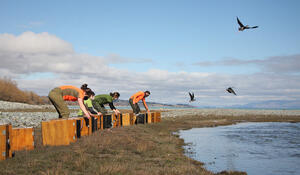
DOC staff release kakī on Toitū Te Whenua managed land near the Tasman River. Photo credit: Liz Brown/DOC.
One fun thing

Photo credit: Agdaily.com
Media contact
Email: media@linz.govt.nz